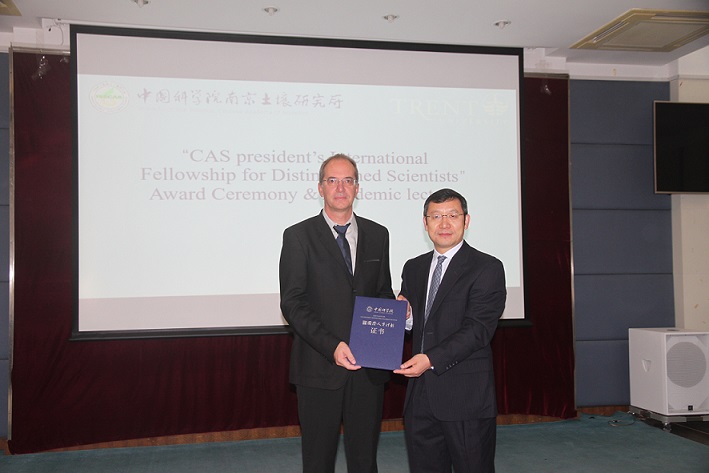Professor Holger Hintelmann from the Trent University was awarded The CAS President’s International Fellowship for Distinguished Scientists in Nov.8, 2017.

Prof. Ganlin ZHANF, deputy director of the Institute of Soil Science, Chinese Academy of Sciences is awarding the certificate of CAS President’s International Fellowship for Distinguished Scientists to Prof. Holger Hintelmann.
Prof. Hintelmann is internationally recognized for his research in the speciation and fate of metals in the environment, with H-index of 50 (36 since 2011). He has pioneered the fractionations of non-traditional isotopes in nature using MC-ICP-MS to reveal their geochemical behaviors and used ‘isotope fingerprint’ for tracking contamination sources. He is one of the scientists to firstly verify the mass-independent fractionation of mercury stable isotope. He has also developed a series of methods which are widely applied nowadays: enriched stable Hg isotopes to trace environmental process, and this method has replaced the traditional radioactive isotope tracer; ID-ICP-MS to determine the ultra-trace metals; a DGT method to determine MeHg bioavailability. In addition, he is involved in a number of field studies on ecosystems from the Arctic to the Amazon, such as METAALICUS、LENS and CARA. These researches have received worldwide attention and have major impacts in the areas of metal biogeochemistry. Prof. Hintelmann is the author or coauthor of 180 publications: 10 edited books or book chapters and 120 peer-reviewed papers including Nature Geoscience, PNAS, GCA and ES&T. The papers have been cited for more than 6400 times. He has given 70 invited plenary and keynote presentations at scientific conferences and been a lecturer at 8 universities and institutes throughout the world. He has trained 57 students, 18 postdoctoral fellows and 15 visiting scholars, two of whom are winners of National Science Fund for Outstanding Young Scholars in China. He has also been the recipient of many awards and honors, including the Trent University Excellence in Research Award (x6), the Premier’s Research Excellence Award and a DFG Research Fellowship.
Two presentations entitled “The use of stable mercury isotopes in environmental studies” and “Assessing the fate for contaminants of concern through whole ecosystem experiments” were introduced by Prof. Holger Hintelmann.
In the presentation of “The use of stable mercury isotopes in environmental studies”, Prof. Holger Hintelmann first introduced the METAALICUS experiment. Isotope enriched mercury was used in METAALICUS (Mercury Experiment To Assess Atmospheric Loading in Canada and the US) which demonstrated that doubling the atmospheric load to the lake surface has increased mercury in fish by 60% within 6 years. After stoppage of mercury additions, levels in small fish declined rapidly, but large fish remained at elevated levels for multiple years. Prof. Holger Hintelmann then introduced the application of mercury isotope signatures as source tracers. To assess the temporal and spatial variation of Hg pollution, water and sediments downwind/downstream of point sources have been measured. For example, mercury emissions from a large smelter in central Canada are characterized by distinct Hg isotopic fingerprints. The δ202Hg in sediments of the lake closest to the source ranged from -0.67 to -1.48 ‰, while Hg in the core furthest away varied from -1.44 to -2.71 ‰. Depth profiles showed similar trends with oldest sediments at all location having more negative isotope ratios. While recent sediments affected by the pollution sources are characterized by more positive values.
In the presentation of “Assessing the fate for contaminants of concern through whole ecosystem experiments”, Prof. Holger Hintelmann introduced two multi-year experiments separately investigating the environmental fate of mercury and of silver nanoparticles. He first introduced the catchment fate and distribution of mercury and the results showed that mercury mainly concentrated in the soil and evaded to the atmosphere. The LENS (Lake Ecosystem NanoSilver) study evaluated the persistence and transformation of silver nanoparticles (AgNPs) in natural lake water using various analytical techniques. Experiments were conducted, in which AgNPs was added to mesocosms and an entire lake. The fate of the added material was monitored over several years to document changes in AgNP agglomeration and dissolution over time. The results showed no discernible changes to food webs but temporarily high levels in fish liver. The results from this study emphasize that multiple analytical techniques are required in order to fully characterize AgNP transformations in the aquatic environment and to overcome the analytical limitations of each method.
